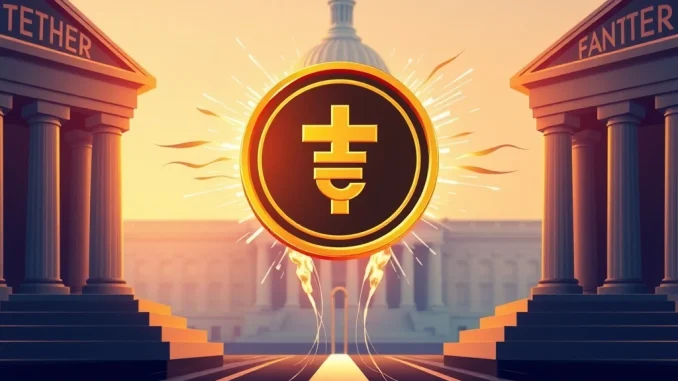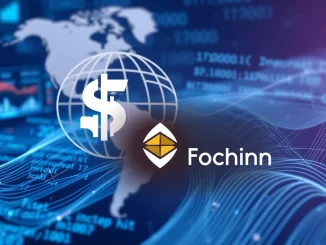
The cryptocurrency world is buzzing with a groundbreaking announcement from Tether, the issuer behind the world’s largest stablecoin, USDT. In a strategic move set to reshape the landscape of digital finance, Tether is pivoting its focus towards the U.S. institutional market with a brand-new institutional stablecoin designed specifically for interbank settlements and corporate treasury management. This shift marks a significant evolution for Tether, signaling its intent to embed itself deeper into traditional financial systems, fueled by recent U.S. crypto regulation.
Tether’s Strategic Pivot: Targeting the U.S. Institutional Market
For years, Tether’s USDT has dominated the retail cryptocurrency space, serving as a vital bridge between fiat and digital assets. With a staggering market capitalization exceeding $162 billion, USDT remains the most traded cryptocurrency by volume. However, CEO Paolo Ardoino recently confirmed a major recalibration: Tether Holdings SA is now setting its sights squarely on the U.S. institutional market.
This isn’t just a minor adjustment; it’s a strategic overhaul. The company is developing a new, distinct stablecoin tailored for:
- Interbank Settlements: Facilitating faster, more efficient transfers between financial institutions.
- Corporate Treasury Management: Offering businesses a stable, digital asset for liquidity and operational efficiency.
- Tokenized Asset Transactions: Enabling the seamless exchange of real-world assets on the blockchain.
This move signals Tether’s ambition to move beyond its retail stronghold and become a foundational component of institutional finance, leveraging its robust infrastructure while navigating complex regulatory demands.
The GENIUS Act: Paving the Way for U.S. Crypto Regulation
A critical catalyst for Tether’s U.S. expansion is the recent enactment of the GENIUS Act. Signed into law by President Donald Trump, this U.S. crypto regulation framework is designed to bring much-needed clarity and legitimacy to the stablecoin market. Ardoino highlighted the GENIUS Act as a pivotal enabler, addressing previous regulatory ambiguities that hindered stablecoin integration into traditional finance.
Key mandates of the GENIUS Act include:
- Full Reserve Backing: Requiring stablecoin issuers to maintain reserves equivalent to their outstanding stablecoins.
- Routine Audits: Mandating regular, transparent audits of these reserves.
- Anti-Money Laundering (AML) Compliance: Enforcing stringent AML protocols to prevent illicit financial activities.
This regulatory clarity is a game-changer. It provides a standardized framework that not only legitimizes stablecoins but also compels all issuers, including competitors like Circle’s USDC, to adhere to higher compliance standards. For Tether, which has faced past criticism regarding audit transparency, embracing these requirements is central to building institutional trust and ensuring long-term competitiveness.
Unpacking the New Institutional Stablecoin for Interbank Settlements
Unlike its retail-focused counterpart, USDT, Tether‘s new institutional stablecoin is engineered for the specific demands of large-scale financial operations. The primary goal is to streamline cross-border payments and enhance interbank liquidity solutions. Imagine instant settlement for large transactions, reducing friction and costs currently associated with traditional banking rails.
While Circle’s USDC has actively pursued public partnerships and regulatory compliance frameworks, Tether has chosen a different path, prioritizing growth through direct institutional collaborations rather than a public listing. Ardoino believes the clarity provided by the GENIUS Act will significantly accelerate the adoption of stablecoins by merchants and financial institutions, particularly in scenarios where instant settlement and liquidity efficiency are paramount. This new offering positions Tether not just as a stablecoin provider, but as a key player in modernizing global financial infrastructure.
Navigating Compliance and Future Growth for Tether
Regulatory compliance isn’t just a hurdle; it’s a strategic imperative for Tether. The company has publicly committed to meeting the GENIUS Act’s rigorous requirements, including routine transparency reports and verifiable reserve attestations. This commitment is crucial for overcoming past perceptions and solidifying its reputation within the highly regulated U.S. financial system.
Ardoino’s ambitious forecast suggests that consistent adherence to these standards could drive a tenfold expansion in USDT’s supply, potentially pushing its market capitalization beyond $1 trillion. This monumental growth, however, hinges on:
- Sustained Regulatory Alignment: Continuous adaptation to evolving regulations.
- Market Trust: Building and maintaining confidence among institutional clients and the broader financial community.
- Operational Execution: Flawless implementation of the new stablecoin and compliance protocols.
The act’s enforcement of full reserve backing and robust AML protocols also raises the bar for the entire stablecoin industry, ensuring a more secure and transparent ecosystem for all participants.
Beyond Stablecoins: Tether’s Broader Blockchain Ambitions
Tether‘s influence extends far beyond its stablecoin offerings. The company boasts an impressive investment portfolio of over 120 companies, including blockchain infrastructure firms like Bitdeer and payment solutions providers such as CityPay. This diversification signals a broader ambition to build out a comprehensive blockchain ecosystem.
Recent strategic partnerships further underscore this vision. For instance, Rezolve AI’s integration of stablecoins into retail payments via its Brain Suite platform highlights Tether’s push to penetrate the massive $30 trillion retail payment market. This collaboration leverages cloud infrastructure from industry giants like Microsoft Azure and Google Cloud, demonstrating Tether’s commitment to institutional-grade scalability and reliability. These ventures illustrate Tether’s long-term strategy: to be a foundational technology provider across various sectors, not just a stablecoin issuer.
Challenges and the Road Ahead
While the GENIUS Act provides a clear regulatory framework, analysts caution that the real test lies in consistent compliance and operational execution. Maintaining unwavering transparency regarding Tether’s reserve structure will be paramount to sustaining trust, especially given its historical challenges in this area. The ability of Tether to navigate these complexities will determine its long-term competitiveness in a market where stablecoins are increasingly vying with traditional liquidity instruments, such as U.S. Treasuries, for institutional adoption. The journey ahead requires not just innovation, but also meticulous adherence to the highest standards of financial integrity.
Conclusion
Tether‘s strategic pivot towards an institutional stablecoin, bolstered by the U.S. crypto regulation of the GENIUS Act, marks a transformative moment for the company and the broader digital asset landscape. By focusing on interbank settlements, corporate treasury, and robust regulatory compliance, Tether aims to solidify its position as a key player in mainstream finance. This ambitious move, while promising significant growth, underscores the critical importance of transparency and consistent execution in the evolving world of U.S. crypto regulation. As stablecoins continue to bridge the gap between traditional and decentralized finance, Tether’s new chapter could redefine how institutions manage liquidity and conduct transactions globally.
Frequently Asked Questions (FAQs)
Q1: What is the primary difference between Tether’s new institutional stablecoin and USDT?
A1: While USDT is primarily designed for retail crypto trading and general use, the new institutional stablecoin is specifically engineered for high-volume interbank settlements, corporate treasury management, and tokenized asset transactions, adhering to stricter U.S. regulatory standards.
Q2: How does the GENIUS Act impact Tether’s operations in the U.S.?
A2: The GENIUS Act provides a clear regulatory framework, mandating full reserve backing, routine audits, and stringent AML compliance for stablecoin issuers. This act enables Tether to operate with greater clarity in the U.S. market, addressing prior regulatory ambiguities and fostering institutional adoption.
Q3: What is Tether’s growth forecast for USDT’s supply?
A3: Tether CEO Paolo Ardoino has forecasted a potential tenfold expansion in USDT’s supply, potentially exceeding $1 trillion, contingent on sustained regulatory alignment and increased market trust following adherence to the GENIUS Act’s requirements.
Q4: How does Tether’s strategy compare to Circle’s USDC?
A4: While both are major stablecoin issuers, Tether is now focusing on direct institutional collaborations and avoiding a public listing, whereas Circle’s USDC has actively pursued public partnerships and broader compliance frameworks to gain traction.
Q5: What are the main challenges Tether faces with this strategic shift?
A5: The main challenges include ensuring consistent compliance with the GENIUS Act’s rigorous requirements, maintaining unwavering transparency regarding its reserve structure, and successfully executing the operational aspects of integrating a new stablecoin into traditional financial systems.
Q6: Beyond stablecoins, what are Tether’s broader ambitions?
A6: Tether aims to diversify into broader blockchain infrastructure and payment solutions, evidenced by its investment portfolio of over 120 companies (e.g., Bitdeer, CityPay) and partnerships like Rezolve AI, indicating a push into the retail payment market and general blockchain ecosystem development.



